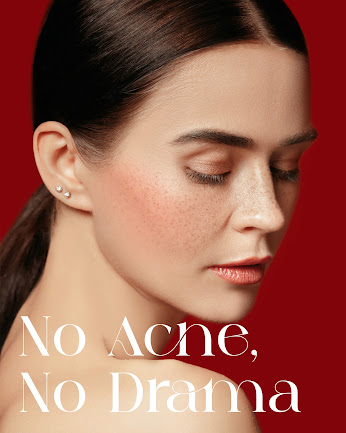Sun Spots & Age Spots: What They Are + How to Prevent & Treat Them
1. What are sun spots / age spots?
-
Sun spots (also called “age spots”, “liver spots”, or “solar lentigines”) are flat, pigmented patches on the skin usually light brown, tan, or dark in colour.
-
They commonly appear in areas exposed to the sun: face, forehead, cheeks, hands, forearms, shoulders.
-
Though more common as we age, younger skin isn’t immune if the sun exposure is frequent and intense.
2. Why do they appear? (Understanding the causes)
To tackle them properly, it helps to know why they show up. Some main causes:
-
UV exposure: Prolonged or repeated exposure to the sun, especially the high-UV midday sun in regions like India, triggers melanin (skin pigment) to accumulate in patches.
-
Skin ageing: With time, the skin’s repair and renewal slows meaning pigmented spots are more likely to linger.
-
Inflammation / irritation: Skin damage e.g., from sunburn, acne, harsh skincare or friction can lead to pigment deposition.
-
Hormonal changes: While less common for standard age spots, hormones can worsen pigmentation (e.g., melasma).
-
Lifestyle & environment: Smoke, pollution, nutritional deficiencies, and not using sun-protection all add up.
3. Spot-the-signs: How to identify them
Check your skin for:
-
Flat patches, usually light to dark brown, often uniform in colour.
-
Spots are generally symmetric and in sun-exposed areas.
-
They do not typically itch, bleed or hurt (unlike some other growths).
-
If you see something that changes shape, colour or size rapidly → get a dermatologist check.
4. Prevention: Your best defence
Since fading spots can take time, prevention is key. Follow these steps:
Step A – Daily Sun Protection
-
Use a broad-spectrum sunscreen (UVA + UVB protection) every day, even if indoors and even on cloudy days.
-
Reapply every 2-3 hours if you’re outdoors (walking, driving, open windows).
-
Wear protective clothing: hats, scarves, long sleeves when possible.
-
Seek shade and avoid prolonged midday sun.
Step B – Consistent Skincare Routine
-
Cleanse gently, use antioxidants + brightening agents, moisturize. A steady routine helps skin renew and fade spots over time.
-
Avoid skipping – even if you’re short on time, a minimal routine is better than none.
Step C – Healthy Lifestyle
-
Eat a balanced diet with plenty of colourful fruits & vegetables (rich in antioxidants).
-
Stay hydrated.
-
Avoid smoking / excessive alcohol both accelerate skin ageing and pigment formation.
-
Sleep well and manage stress your skin regenerates best when your body is rested.
5. Treatment: How to fade existing spots
You have many routes some at home, some skincare actives, and in some cases dermatological treatments. Here’s a step-by-step guide:
Step 1: Gentle exfoliation
-
Use gentle exfoliants 1-2 times a week (e.g., mild AHAs like glycolic acid, lactic acid) to help remove pigmented skin layers and encourage renewal.
-
Always follow up with sunscreen, because exfoliating can make skin more sun-sensitive.
Step 2: Brightening / active ingredients in your daily routine
Look for ingredients that are proven to help with pigmentation:
-
Vitamin C (ascorbic acid) – an antioxidant that reduces melanin production.
-
Niacinamide (vitamin B3) – supports skin barrier, reduces pigment transfer.
-
Alpha-arbutin – milder brightener, suitable for sensitive skin.
-
Retinol (vitamin A derivative) – helps accelerate cell turnover and fade spots. Use at night, with care.
-
Sunscreen must stay in the equation actives alone won’t help if you continue unprotected sun exposure.
Step 3: Targeted treatments / dermatologist help
If your spots are very stubborn:
-
Chemical peels (light to moderate)
-
Laser treatments (IPL, fractional)
-
Microneedling + pigment-targeting serums
-
Always consult a dermatologist to check the spot type and recommend safe treatment for Indian skin (higher risk of post-inflammatory hyper-pigmentation).
6. Sample Routine for Indian Skin (morning + night)
Morning
-
Gentle cleanser
-
Antioxidant serum (e.g., Vitamin C)
-
Moisturiser (light, non-comedogenic)
-
Broad-spectrum sunscreen (SPF 30 or more)
Night
-
Cleanser
-
Exfoliant (2-3 times a week) or retinol (nightly if tolerated)
-
Brightening serum (niacinamide, arbutin)
-
Moisturiser or sleeping mask
7. FAQs – quick answers
-
Will age spots disappear completely? Some lighten significantly; complete removal may not always be possible. Consistency matters.
-
Can I skip sunscreen if I only go out at night? No indoor windows, ambient light can still trigger UV, and prevention is essential.
-
Is lemon juice / natural home remedy enough? Natural remedies may help marginally but are not substitutes for clinically backed ingredients and sun protection.
-
When should I see a doctor? If a spot changes size, colour, shape, or begins to bleed/itch see a dermatologist.
8. Conclusion
Sun spots and age spots may seem inevitable, but the right strategy shifts the balance: prevention + smart skincare + patience. For Indian skin, where sun exposure is often higher and pigmentation concerns more visible, adopting a daily sun-protection mindset plus effective actives is your best bet. Start today to protect your skin and gradually fade those marks your future glow will thank you.
FOR MORE INFORMATION VISIT
Meet Your New Self-Care Ritual: Cathy Doll’s Shiny Purple Cabbage Mask for Deep Hydration & Clarity
Say Goodbye to Redness & Puffiness with This Cooling Cucumber Mask
Say Goodbye to Dry, Irritated Skin: Meet Your New Aloe Vera Moisture Shield
Why Your Body Care Routine Needs Smart Actives — Not Just Any Lotion?
Why Hyperpigmentation Happens & How to Maintain Even, Glowing Skin?
Why Your Skin Looks Darker Even Without Sun Exposure?
Why Hyperpigmentation Happens & How to Maintain Even, Glowing Skin?




Comments
Post a Comment